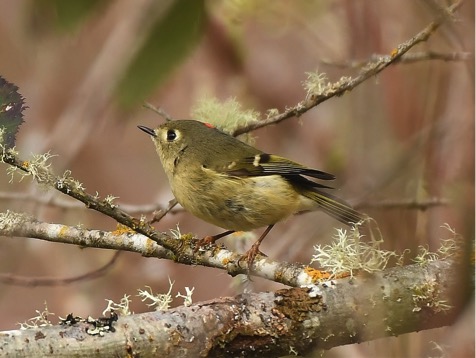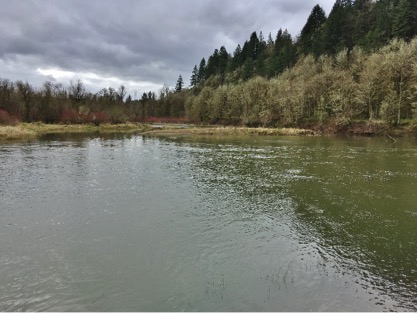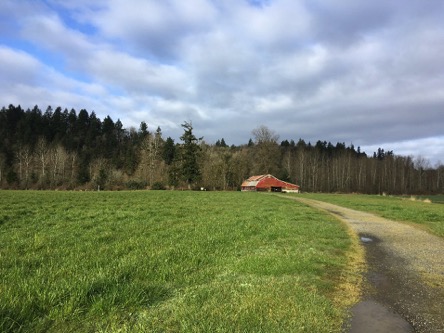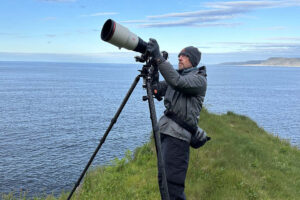Rachel Hudson – March 27, 2021
Map: Chehalis River Discovery Trail; eBird: Centralia Discovery Traill
As most birders know, sometimes it’s the small, overlooked, easy-to-miss spots that offer the greatest experiences outdoors. This is definitely true of the Discovery Trail in Centralia. With a common-sounding, somewhat forgettable name, and located at the absolute end of a hidden residential road just on the edge of town, the Discovery Trail is not a place oft-discussed in the birding world outside of Lewis County. Here, however, we know it to be an exciting location that provides opportunities for good and sometimes rare birds year-round.
To find the secluded Discovery Trail, head toward Centralia; if you’re coming from Olympia, take Exit 88 off of I-5, turn right onto Old Highway 99/Highway 12, and take a left at the light onto Old Highway 99/Elderberry Street. After about 3.25 miles, there will be a yellow sign for Goodrich Road on your right, and below it, a small brown sign for the Discovery Trail. Goodrich Road is narrow and easy to miss, so it’s a good idea to slow down at that point and find the road entrance in the sea of small driveways; the road will be just after a chain link fence, and across from the Port of Centralia industrial park. If you’re coming from south of Centralia, take Exit 82 and turn left onto Harrison Ave. Stay on that road for about 2.4 miles, until you see an identical yellow sign for Goodrich Road with a brown one below it for the Discovery Trail (the sign will be on your right, but you will be turning left). Here, you’re lucky; you get a convenient left turn lane.
Goodrich Road in and of itself is chock full of good birds, which is even more incentive to drive slowly and respectfully. This is a tight little residential area, and birding from your car will give you mixed flocks of sparrows and juncos at feeders, hummingbirds zipping around, the occasional Merlin stalking the activity, and Flickers and Sapsuckers scattered about. Rarely, California Quail can be spotted in shy coveys around dense shrubs. Be courteous to the people here; most of them know about birders and are aware of the trail at the end of the road, but have said to please refrain from looking in their windows or blocking the road or driveways. The bridge after the houses is a good place to pause for a moment in your car, if there is no one driving behind you. From your car, glance over the edges of the bridge into the wide, still waters of Dry Creek for waterfowl such as Ring-necked Ducks, Wood Ducks, Mallards, and more. On today’s trip, though, all I found was a small flock of American Wigeon there.
Continue down the little road until you approach the Centralia Wastewater Treatment Plant. It is here that you will need to park to access the trail. Directions to the little gravel parking area on the right are well-posted, so follow the signs. (Also, though there is a restroom here, it has been locked most times I’ve been to the trail, presumably due to the current world situation.) Once parked, let the adventure truly begin!
Look around you here for common flocking birds such as House Finches and Dark-eyed Juncos, and large flocking birds in the open field such as Cackling and Canada Geese. During the winter, huge flocks of gulls roost on the rooftops of the wastewater treatment plant, but most of them have gone at this time of year. Violet-green Swallows preened on the power lines overhead as I wandered this morning, and music from Song Sparrows and an ever-present onslaught of American Robins filled the air. To get to the trailhead proper, keep walking down the road you were on, as the trail is a sort of closed-off continuation of that road. Follow the signs and pay attention to the rules as they are posted.
The trail is fairly wheelchair/walker friendly, as there are only slight inclines in a few spots, and it is wide, with the entrance at the gate also wide enough to get through. There are a couple places on the trail where the gravel has been washed out from heavy rainfall and large puddles/dips remain, but most or all are easy enough to get around on the side, in the grass. Nearly all of the main part of the trail is varying sizes of gravel (some thin and packed, some very coarse rocks), so it would be a bumpy ride if in something with wheels, though I often see mothers taking babies in strollers on walks/jogs here. Pets are also allowed, so long as they stay on a leash, and pet waste disposal bins are regularly placed.
If you enjoy packing a scope out with you on birding adventures, the trailhead is a good place to use one. On the right, there is a large field that becomes a seasonal pond, varying in size based on how much rainfall we receive. Today, a large flock of Northern Shovelers covered the shallow water, and Green-winged Teal dotted the water’s edges. It is here where great shorebirds tend to show up during migration; one of the few places sandpipers and other shorebirds can be seen in Lewis County. Today, Greater Yellowlegs and Killdeer crept about in the short grasses and mud.
As you follow the gravel trail through the fields toward the river, look everywhere for birds! American Kestrels will be tucked away in the high branches of prominent trees, or surveying the fields from various fence posts. Golden-crowned Sparrows and more Song Sparrows sing and call from the brush, and Tree Swallows chirp and swoop over the fields. Northern Harriers and Red-tailed Hawks coast to and fro, and both Anna’s and Rufous Hummingbirds (my First of Year Rufouses) are singing from perches when I was there. The trail takes you down to the Chehalis River, where the trail splits for a short distance in both directions along the river, no loops. Shortly before the split, there is a picturesque large red barn, and when the Cliff Swallows arrive, they will build their nests all along the barn’s roof edge, offering up-close views of their activities.
Today, though there were no Cliff Swallows, other year-round species covered the trees and ground and made their presence known through scrappy territorial battles and nonstop song. The riverside was alive with Ruby-crowned Kinglets, each of them singing and calling loudly as they chased each other through the short, bare trees. Their noble ruby crowns flashed brightly, and they flitted all around me the entire time. Golden-crowned Kinglets also sang from the lower trees, and it was a treat to watch them at a closer range for once.
A pair of Bald Eagles has nested there over the river for many years, and one was sitting in their nest today, with the other hunting from a treetop over the river not far away. There are a few places on the north part of the trail, where I walked first, where you can see down into the river, using caution not to get too close to the edge. In the rocks, more Killdeer wander, and today, a male Common Merganser rested on the dry rocks in the middle of the river alongside a pair of Canada Geese. The end of the north trail is temporarily closed, perhaps due to flood damage from earlier this winter, but the part that is still open is well worth exploring.
Turning back to walk the south end of the trail, more Kinglets of both species sang constantly, and a Varied Thrush eyed me from deep in the branches of the thickening trees on the riverside. More Robins and Song Sparrows added to the constant melody, and Red-breasted Sapsuckers called and drummed to each other on either side of the river. Flowers are beginning to bloom here, and catkins are forming on the trees. Dewdrops coated tiny new leaves, and pausing to take in all the little details in the flora around me was soothing and healing. One of the Kestrels called as it landed on a nearby fencepost, and the now-distant flock of Cackling and Canada Geese took off, creating a faint roar of their calls in the sky.
The south part of the trail leads into a patch of tall evergreens at a bend in the river. Here, birds that prefer the forest such as Red-breasted Nuthatches and Brown Creepers call in the dark trees, and the tracks of deer dot the edges of the trail. The gravel eventually stops, and there is a well-worn dirt path that enters the little forest patch and leads straight down to the river itself, where you can sit on the rocks and eat a nice lunch by the water, as I did today. As I sat there, Hairy Woodpeckers called in the distance, a Pacific Wren’s song echoed over the river, a Northern Flicker laughed overhead, and the Common Merganser from earlier flew upstream just to float all the way back down past me again minutes later.
In all, I walked 3 miles (with much “birder’s meandering” adding to that) round trip. The trail is simple, flat, and quiet. Not many people use the Discovery Trail, so if avoiding crowds is desired, then it’s definitely a good option. Being alongside the river gives this trail plenty of good habitat year-round for wildlife. In my adventuring there this morning, I encountered 48 species of birds, which is rather good for this time of year. This little hidden gem of a trail has always been worth my time. Many memories from it will stay with me forever, such as getting the treat of listening to a pair of Kestrels quietly talking to each other as they sat side by side in a nearby tree, and my Lifer flock of Trumpeter Swans soaring low overhead with me gaping up in awe at the small-aircraft-sized birds, about a decade ago. The Discovery Trail is always a happy, quiet escape into nature. All photos by Rachel Hudson
BEFORE YOU GO:
Before heading off for a birding adventure, here are some things to consider –
1. It’s always best to have a partner with you – both to maximize the joy and to minimize the risks. BHAS cannot ensure that these locations are totally safe.
2. Don’t forget to bring your mask and hand sanitizer. Have your mask handy and put it on when passing another person not in your party.
3. Leave valuables at home.
4. Check the weather and the bird reports before heading out. An easy way to check what birds have been seen is through Birder’s Dashboard http://birdingwashington.info/dashboard/. It is a simple way to research a species, place, or checklist.











